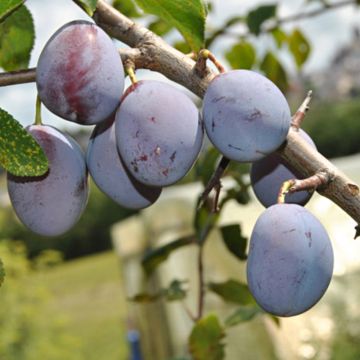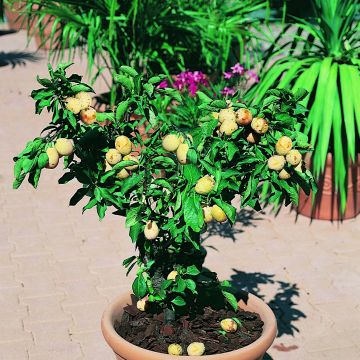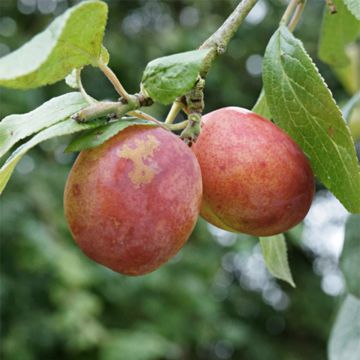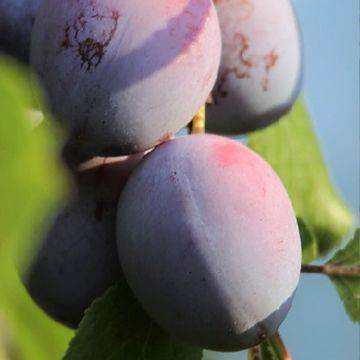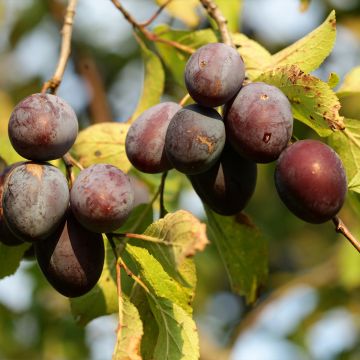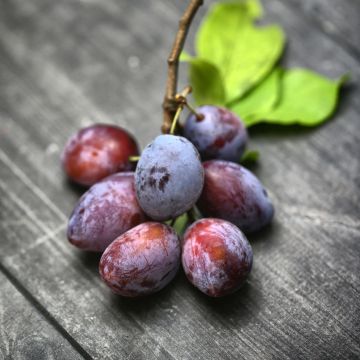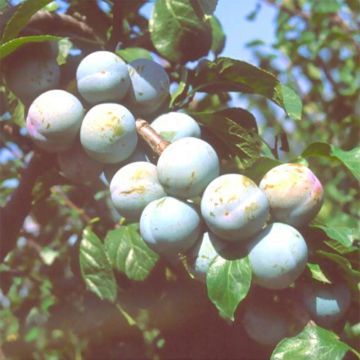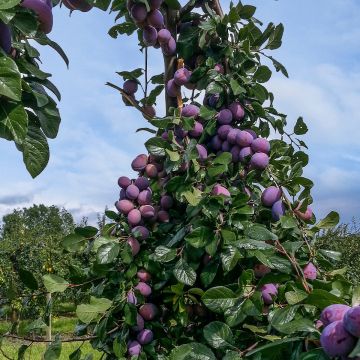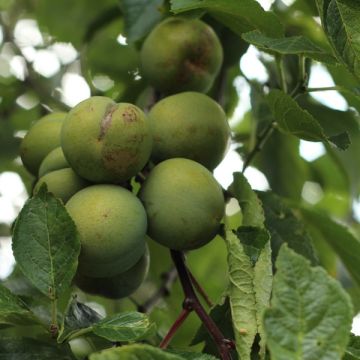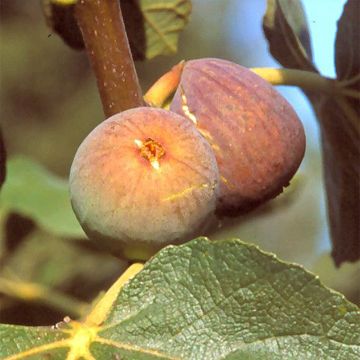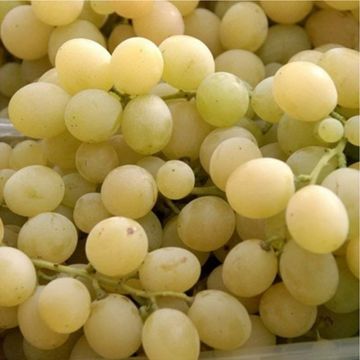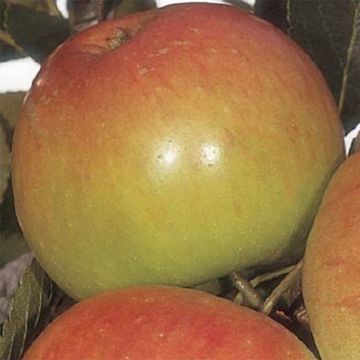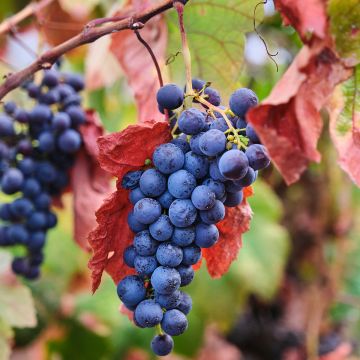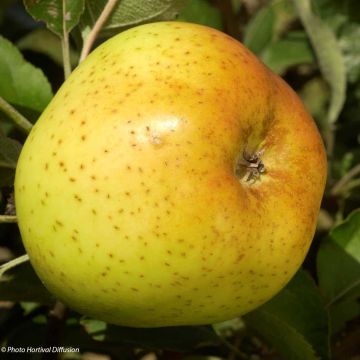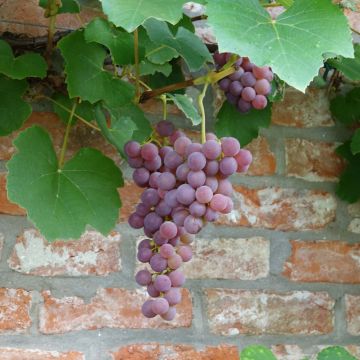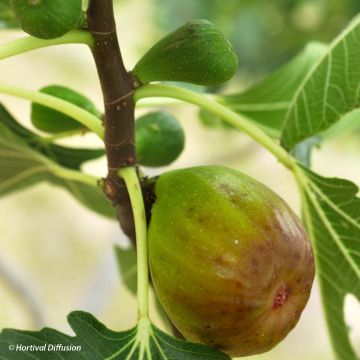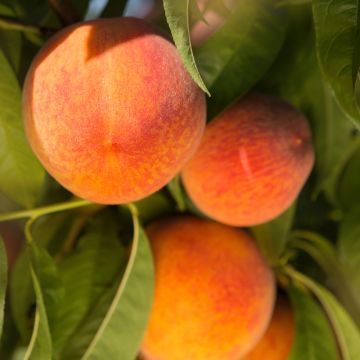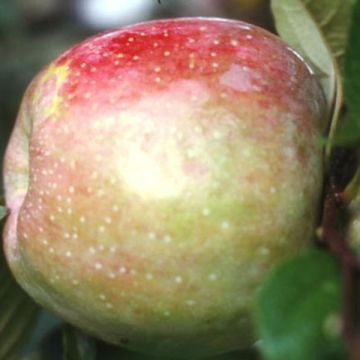

Duo of plum trees
Duo of plum trees
Prunus domestica Opal, Victoria
European Plum, Common Plum
This item cannot be shipped to the selected country
Oversize package delivery charge from €6.90
More information
Schedule delivery date,
and select date in basket
This plant carries a 6 months recovery warranty
More information
We guarantee the quality of our plants for a full growing cycle, and will replace at our expense any plant that fails to recover under normal climatic and planting conditions.
Oversize package: home delivery by special carrier from €6.90 per order..
Express home delivery from €8.90.
Description
The Opal and Victoria Plum make a very competitive pair for producing a harvest spreading from late July to late September. They complement each other in flowering and offer abundant fruiting on a single tree. These varieties, grafted on the same rootstock, produce yellow-fleshed, juicy, and highly fragrant fruits, with Opal producing dark red plums and Victoria producing larger red-purple fruits. Once the spring flowering is over, the plum tree is adorned with dark green foliage, providing welcome shade in summer. It is resistant to cold and requires ordinary, well-drained, moist, rich, and deep soil, but not limestone, and without stagnant moisture. Ornamental and fruitful at the same time, this duo finds a place in isolation on a lawn or within a flower bed, orchard, or fruit hedge. Perfect for small gardens.
This tree brings together two grafts:
- An Opal Plum graft: A vigorous and early, self-fertile and very productive variety. It is a small, ovoid plum, 2.5 to 3 cm in diameter, dark red, with firm, juicy, and sweet yellow flesh, with a finely fragrant flavour. They are mainly consumed fresh, but they are also ideal for making pies, clafoutis, and jams. It is highly resistant to diseases and is a very effective pollinator. It can be harvested from late July to mid-August.
- A Victoria Plum graft: A less vigorous but highly productive variety. Large elongated to ovoid fruits, 4 to 5 cm in diameter, red-purple with a yellow background, with yellow, semi-firm, and highly fragrant flesh. Harvest begins in early September. This self-fertile variety is also a good pollinator.
Prunus domestica (Common Plum) is a fruit tree belonging to the Rosaceae family, just like the apricot tree, almond tree, and peach tree. It is native to Syria, where it sometimes grows up to 1000 metres in altitude. The 'Opal' variety was selected in 1925 by the Alnarp Research Institute in Sweden and is the result of cross-breeding between the Early Favourite and Reine-claude d'Oullins varieties. The 'Victoria' variety was first described in literature in 1856. It originated from a seedling found in Alderton, Sussex, in Great Britain, and was dedicated to Queen Victoria of England.
This plum tree forms a fruit tree with a fairly rounded framework that can reach a final height of about 5 metres, producing numerous branches grouped in spreading crowns. Its habit is well suited to free forms on standard, half-half, or bush stems. Its deciduous foliage is composed of obovate, 6 to 8 cm long, crenate and toothed leaves, slightly hairy underneath and dark green. Towards the end of March for 'Opal' and the beginning of April for 'Victoria', white, 1.5 to 2.5 cm diameter flowers appear solitarily before the leaves on the previous year's branches. The flowering is sensitive to spring frosts, but it is so abundant that frost rarely compromises the harvest. It has a remarkably decorative flowering in spring, particularly nectar-rich. It is hardy to -20°C. These are two self-fertile varieties, so they do not need a companion to bear fruit. The flowers can self-pollinate, but their presence, close to each other, allows for cross-pollination, thus increasing the number of fruits.
These two plum varieties grafted on the same tree offer abundant, regular and quick fruiting, around 3 to 4 years, optimal fruit production is achieved after 5 to 7 years. An adult plum tree (between 10 and 20 years) produces an average of 35 to 50 kilograms of fruit per year. The first harvests can start with Opal in late July, then continue with Victoria in September, as they ripen. Since plums are quite fragile, they are carefully harvested with a picking pole or manually with a ladder. The fruits are consumed right after harvest. Delicious and delightful plums can be eaten fresh, raw, or mixed in a fruit salad or dessert. They are also exquisite in clafoutis, cakes, crumbles, or pies, and as an accompaniment to savoury dishes with white meats (turkey, chicken, veal...) or tagines. They are also perfect for making jams, compotes, juices, or preserved fruits in syrup.
The plum is a light and balancing fruit. It is low in calories and rich in potassium, calcium, and magnesium, with a significant iron content. Its content of vitamins C, B, E, and K, phenolic antioxidants, and fibre make the plum a healthy choice. It is invigorating, energising, and rehydrating. The fruits can only be stored for a few days at room temperature. However, they can be frozen once washed, dried, and pitted, or preserved in jams or syrup.
Report an error about the product description
Duo of plum trees in pictures


Plant habit
Fruit
Flowering
Foliage
Botanical data
Prunus
domestica
Opal, Victoria
Rosaceae
European Plum, Common Plum
Cultivar or hybrid
Other Plum Trees
Planting and care
The perfectly hardy Plum tree can withstand temperatures below -15°C and can be grown up to 1,000 metres above sea level. Cultivated under good conditions, it is one of the easiest fruit trees to grow, as it is both generous and resistant. Plum trees bloom early in spring and are therefore exposed to frost, although frost rarely affects plum harvests. Avoid areas that are too exposed to north and east winds in the coldest regions. To produce beautiful fruits, the plum tree likes heat and sunlit locations sheltered from strong winds (the branches are very brittle). It is a vigorous tree that can grow in any type of soil, although it prefers rich, moist, deep, and well-drained, slightly acidic soil, without stagnant moisture or excessive limestone. It only truly fears waterlogged soils. The plum tree is only grown in free forms, known as open centre. With its white blossom, it brings a touch of freshness to natural gardens and orchards in spring.
Plant your Plum tree from November to March during the vegetative rest period, outside of the frost period. Container-grown trees can be planted all year round as long as the soil is neither frozen nor waterlogged. Don't forget to dress and prune before planting. In open ground, you can plant plum trees in groups of 3 or 5, spacing the trees 6 to 7 metres apart.
Prepare the soil well. Dig a large planting hole at least 3 times the size of the root ball (80x80 cm). Ensure drainage with some gravel. Place the tree in the hole and plant a stake without tying it too tightly. Fill in and tamp down the soil with garden soil enriched with compost, well-rotted manure, and 2 or 3 handfuls of crushed horn, without burying the graft collar (leave the graft point 10 cm above the ground). Form a basin around the base and water abundantly and regularly to help your plum tree establish itself.
After planting, for the first three years, water regularly as the soil should remain moist throughout the summer. It does not like overly dry soils. If there is a lack of water, its fruits may fall prematurely. After 2 or 3 years, it will better tolerate a short period of drought. Mulch the base of your plum tree during the first few years with dry vegetation (bark, dead leaves, straw, etc.) to keep it cool in summer.
If necessary, thin out the fruits. Ripe plums attract wasps: collect fallen fruits from the ground. If necessary, remove shoots that have grown at the base of the tree, but be careful when hoeing, as its roots are shallow. In autumn or spring, apply manure or fertiliser for fruit trees.
Planting period
Intended location
Care
This item has not been reviewed yet - be the first to leave a review about it.
Ancient and local varieties
Haven't found what you were looking for?
Hardiness is the lowest winter temperature a plant can endure without suffering serious damage or even dying. However, hardiness is affected by location (a sheltered area, such as a patio), protection (winter cover) and soil type (hardiness is improved by well-drained soil).

Photo Sharing Terms & Conditions
In order to encourage gardeners to interact and share their experiences, Promesse de fleurs offers various media enabling content to be uploaded onto its Site - in particular via the ‘Photo sharing’ module.
The User agrees to refrain from:
- Posting any content that is illegal, prejudicial, insulting, racist, inciteful to hatred, revisionist, contrary to public decency, that infringes on privacy or on the privacy rights of third parties, in particular the publicity rights of persons and goods, intellectual property rights, or the right to privacy.
- Submitting content on behalf of a third party;
- Impersonate the identity of a third party and/or publish any personal information about a third party;
In general, the User undertakes to refrain from any unethical behaviour.
All Content (in particular text, comments, files, images, photos, videos, creative works, etc.), which may be subject to property or intellectual property rights, image or other private rights, shall remain the property of the User, subject to the limited rights granted by the terms of the licence granted by Promesse de fleurs as stated below. Users are at liberty to publish or not to publish such Content on the Site, notably via the ‘Photo Sharing’ facility, and accept that this Content shall be made public and freely accessible, notably on the Internet.
Users further acknowledge, undertake to have ,and guarantee that they hold all necessary rights and permissions to publish such material on the Site, in particular with regard to the legislation in force pertaining to any privacy, property, intellectual property, image, or contractual rights, or rights of any other nature. By publishing such Content on the Site, Users acknowledge accepting full liability as publishers of the Content within the meaning of the law, and grant Promesse de fleurs, free of charge, an inclusive, worldwide licence for the said Content for the entire duration of its publication, including all reproduction, representation, up/downloading, displaying, performing, transmission, and storage rights.
Users also grant permission for their name to be linked to the Content and accept that this link may not always be made available.
By engaging in posting material, Users consent to their Content becoming automatically accessible on the Internet, in particular on other sites and/or blogs and/or web pages of the Promesse de fleurs site, including in particular social pages and the Promesse de fleurs catalogue.
Users may secure the removal of entrusted content free of charge by issuing a simple request via our contact form.
The flowering period indicated on our website applies to countries and regions located in USDA zone 8 (France, the United Kingdom, Ireland, the Netherlands, etc.)
It will vary according to where you live:
- In zones 9 to 10 (Italy, Spain, Greece, etc.), flowering will occur about 2 to 4 weeks earlier.
- In zones 6 to 7 (Germany, Poland, Slovenia, and lower mountainous regions), flowering will be delayed by 2 to 3 weeks.
- In zone 5 (Central Europe, Scandinavia), blooming will be delayed by 3 to 5 weeks.
In temperate climates, pruning of spring-flowering shrubs (forsythia, spireas, etc.) should be done just after flowering.
Pruning of summer-flowering shrubs (Indian Lilac, Perovskia, etc.) can be done in winter or spring.
In cold regions as well as with frost-sensitive plants, avoid pruning too early when severe frosts may still occur.
The planting period indicated on our website applies to countries and regions located in USDA zone 8 (France, United Kingdom, Ireland, Netherlands).
It will vary according to where you live:
- In Mediterranean zones (Marseille, Madrid, Milan, etc.), autumn and winter are the best planting periods.
- In continental zones (Strasbourg, Munich, Vienna, etc.), delay planting by 2 to 3 weeks in spring and bring it forward by 2 to 4 weeks in autumn.
- In mountainous regions (the Alps, Pyrenees, Carpathians, etc.), it is best to plant in late spring (May-June) or late summer (August-September).
The harvesting period indicated on our website applies to countries and regions in USDA zone 8 (France, England, Ireland, the Netherlands).
In colder areas (Scandinavia, Poland, Austria...) fruit and vegetable harvests are likely to be delayed by 3-4 weeks.
In warmer areas (Italy, Spain, Greece, etc.), harvesting will probably take place earlier, depending on weather conditions.
The sowing periods indicated on our website apply to countries and regions within USDA Zone 8 (France, UK, Ireland, Netherlands).
In colder areas (Scandinavia, Poland, Austria...), delay any outdoor sowing by 3-4 weeks, or sow under glass.
In warmer climes (Italy, Spain, Greece, etc.), bring outdoor sowing forward by a few weeks.


































